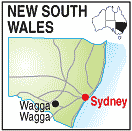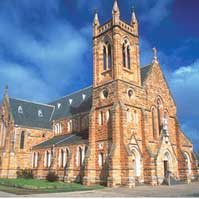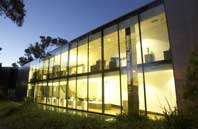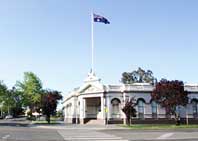| WAGGA WAGGA - NEW SOUTH WALES | ||||||||

| ||||||||
|
The City of Wagga Wagga is the regional centre of the rich agricultural and
pastoral district of The Riverina. It comprises an area of around 500,000 hectares
with a population on 55,000 and was first settled in the 1830's following an
1829 expedition of exploration to trace and chart the vast inland rivers system
of the interior. Captain Charles Sturt, with George Macleay and six others followed
the Murrumbidgee to its junction with the Murray River, near Mildura, and on
to the mouth near Goolwa in South Australia.
In 1849 Thomas Townshend surveyed the main city area and it was declared a town in the same year. In the 1860's there was a population of around 700 residents, and by 1881, after the railway was extended in 1879, the population reached 4,000. It takes its name from the aboriginal Wiradjuri tribe, the largest in New South Wales, who called it 'Wagga' or 'Wahga', meaning 'crow'. The double use of the word indicates 'many crows', and this double meaning is common to the area with such names as Gumly Gumly, Walla Walla and Grong Grong all located nearby. Aboriginal heritage is well preserved in the place names of Australia with some 35% of names having their origin in the aboriginal language. A perusal of the area map on this page will reveal such free-rolling names as Woomargarma, Muttama and Little Billabong, all derived from aboriginal dialects. The Murrumbidgee River which flows through the city means 'big water'. Rich soil and extensive and reliable water supplies from the Murrumbidgee River and sub-terranean sources have enabled the town to prosper. Numerous trees line the streets and the city is renowned for its magnificent parks and gardens. The Botanical Gardens, incorporating a modern Zoological section, is situated just south of the Sturt Highway off Lord Baden Powell Drive and is a pleasant stop-over. Over 600 species of native trees and shrubs are featured and there is an Exotic Flora section; Camellia Garden; Cacti and succulent section; and rain-forest plants. Many native and exotic animals can be seen in the Zoological Gardens. For children there is a well-appointed playground, and a miniature railway which operates on the first and third Sunday of the month. Cabarita Beach, only a short walk from the Information Centre in Tarcutta St. is a popular venue for locals and visitors and has a swimming beach on the river, picnic areas and BBQ's. It is floodlit of a night during the summer months. Modern sporting facilities cater to the needs of everybody. The Wagga Wagga Swimming and Recreation Centre in Bolton Park, easily located by the 'Rippa Slippa' water slide, is an integrated sport and leisure complex for all the family, with solar-heated swimming pools, mini golf, a skateboard ramp, tiny tots area, BBQ facilities and a kiosk. Incorporated within the centre is a modern gymnasium. Spacious and well-equipped, with universal machines, unlimited free weights, a specially designed aerobics floor, and offering personalised tuition in all aspects of fitness needs, it is the equal of any facility in the country. (The centre is closed for renovations during 2002). There are two excellent golf courses open to visitors. One west of town on the Sturt Highway and another south of the city on Lake Albert off Plumpton Rd. A Par 3 course will be found across the river to the north on Hampden Rd. (Olympic Way). Other sporting facilities include several bowling clubs, 10 pin bowling, numerous football and cricket ovals, (the current Australlian 11 cricket captain Mark Taylor is from Wagga Wagga), and netball and tennis courts. The Murrumbidgee and local tributaries offer excellent fishing for the enthusiast, presenting the opportunity to bag Murray Cod, Fresh-water Catfish, Perch and Yabbies, a fresh-water crayfish. The Murray Cod Hatcheries and Fauna Park east of the city on the Sturt Highway is a major attraction and hires fishing tackle, has a kids fishing pond, and conducts fly-fishing lessons. There is an indoor multi-aquarium display with many live native fish and crustacea, an extensive range of native animals and wildlife can also be seen, and there is a lawn area, a children's playground and quality facilities. The Kapooka Military Camp is located 10km. west of the city off the Olympic Way. Graduation Parades are normally held each Monday morning and tours of the base are possible for visitors who report to the Guard Room at the main gate. The Charles Sturt University, north of the city off the Coolamon Rd., has a commercial vineyard, a winery and a cheesery. A large variety of wines are produced by the University's resident winemaker, assisted by staff and students. Visitors can sample the products in the Don Potter Centre tasting area between 10am. and 4pm. weekdays, and from 11am. to 4pm. Saturdays. The Wagga Wagga Winery is located among 5 acres of vines on the Oura Rd.(Gundagai Rd.) north east of the city and provides meals and tastings every day at a reasonable price. Ph: 6922 1221 for information. PLACES OF INTEREST:
INFORMATION CENTRE: Wagga Wagga Visitor Information Centre Tarcutta Street. Wagga Wagga NSW 2651 Open from 9.00 am to 5.00 pm 7 days. Ph: 1800 100 122. HOW TO GET THERE: Domestic airport, daily coach and rail by road along the Sturt Hwy from Adelaide, Sydney, Canberra Along the Hume Hwy and Olympic Way from Melbourne via Albury-Wodonga. | ||||||||

|
© Copyright Peter W. Wilkins | |



